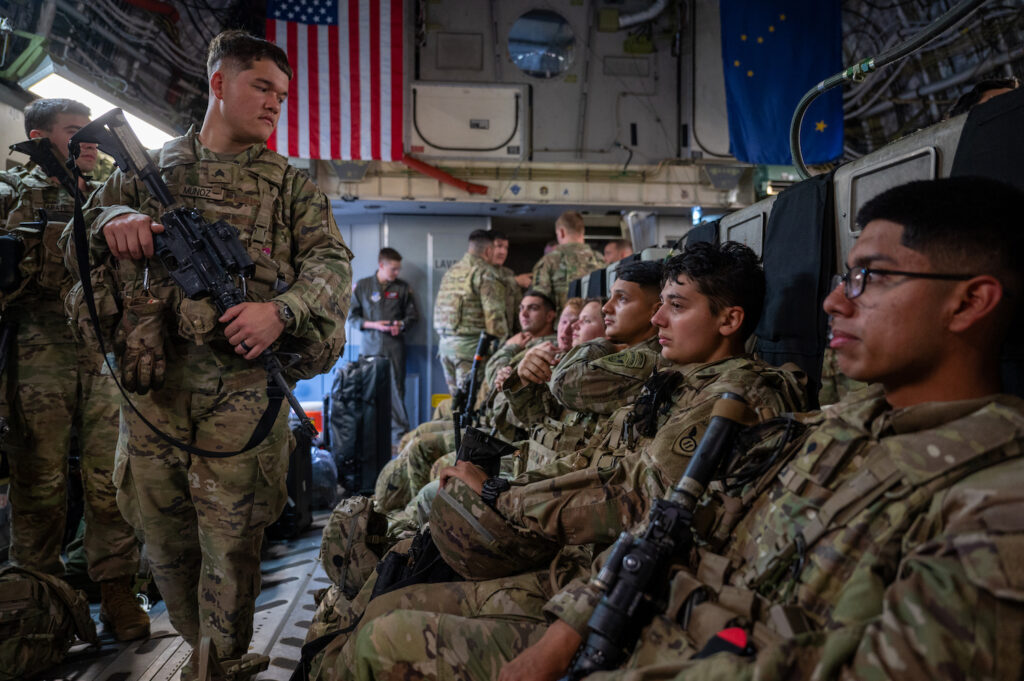U.S. Army Soldiers assigned to 1st Battalion, 501st Parachute Infantry Regiment, 2nd Infantry Brigade Combat Team (Airborne), 11th Airborne Division, board a U.S. Air Force C-17 Globemaster III assigned to the 176th Wing, Alaska Air National Guard, ahead of a force projection operation to Shemya Island in the North Pacific Ocean, at Joint Base Elmendorf-Richardson, Alaska, Sept. 11, 2024. (U.S. Air Force photo by Airman 1st Class Hunter Hites)
The U.S. Army has deployed airborne soldiers from within Alaska and additional soldiers from Hawaii and Washington to isolated Shemya Island in the Aleutians, it announced late last week.
The deployment, first reported by Stars and Stripes, is a test of the Army’s ability to move fast, said the commanding general of the 11th Airborne Division, based at Fort Wainwright, near Fairbanks.
“Testing ourselves with this operation and others like it is critical to our nation’s defense and the preservation of a free and open Indo-Pacific,” said Maj. Gen. Joseph Hilbert in a written statement. “Our ability to deploy combat-credible forces quickly and effectively to any location, no matter how remote, is critical to supporting the nation and our strong relationships with allies and partner nations.”
It’s the first time since 2018 that Fort Wainwright soldiers have deployed to Shemya, the isolated home of Eareckson Air Station and the closest American military base to Russia.
Eareckson is 280 miles from the nearest Russia-owned island and 645 miles from Petropavlovsk, the capital of the Russian territory of Kamchatka.
The deployment, which began last week, also includes elements of the 1st and 3rd Multidomain Task Forces. Those task forces operate a variety of equipment, including HIMARS, a kind of mobile rocket artillery currently used by Ukraine in its war against Russia.
A HIMARS unit previously deployed to Shemya in 2020, and Navy SEALs conducted an exercise on the island last September.
Advance elements of the units arrived Sept. 8, with more arriving on Sept. 12. That coincides with Ocean 2024, a joint military exercise between China and Russia in the Sea of Japan.
Separate from that exercise, six Russian patrol aircraft flew through an air defense zone near Alaska between Friday and Sunday, NORAD reported. The air defense zone is in international airspace, and no foreign aircraft entered American airspace.
In June, Russia and China conducted an unprecedented joint bomber patrol through the air defense zone, Hilbert noted.
“As the number of adversarial exercises increases around Alaska and throughout the region, including June’s joint Russian-Chinese bomber patrol, the operation to Shemya Island demonstrates the division’s ability to respond to events in the Indo-Pacific or across the globe, with a ready, lethal force within hours,” he said.
The Army did not say when the Shemya deployment will conclude, but prior operations have ended before the start of winter, which brings extraordinarily bad weather to the Aleutians.
This article was first published by the Alaska Beacon, part of States Newsroom, a nonprofit news network supported by grants and a coalition of donors as a 501c(3) public charity. Alaska Beacon maintains editorial independence. Contact Editor Andrew Kitchenman for questions: info@alaskabeacon.com. Follow Alaska Beacon on Facebook and X.

